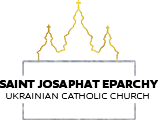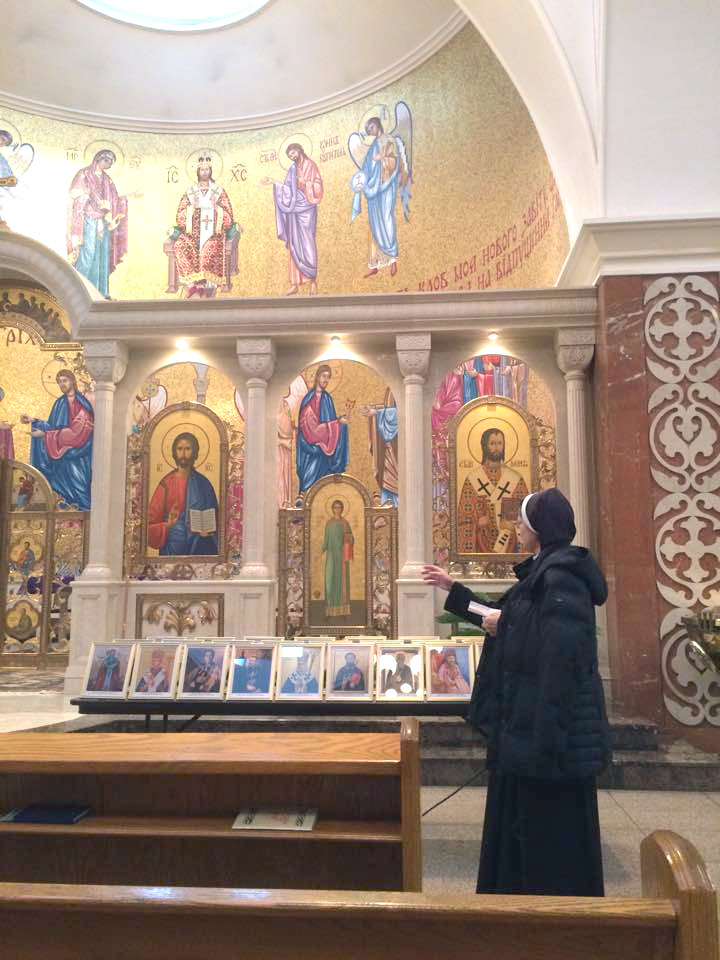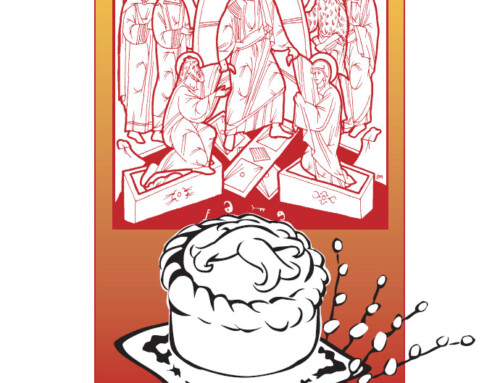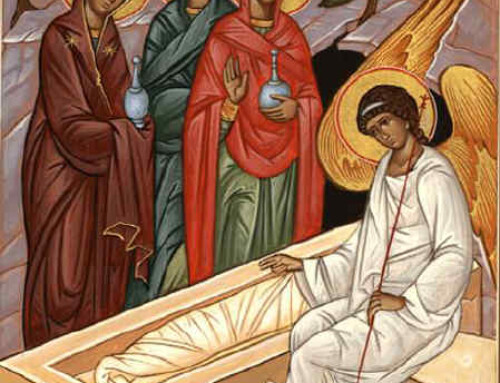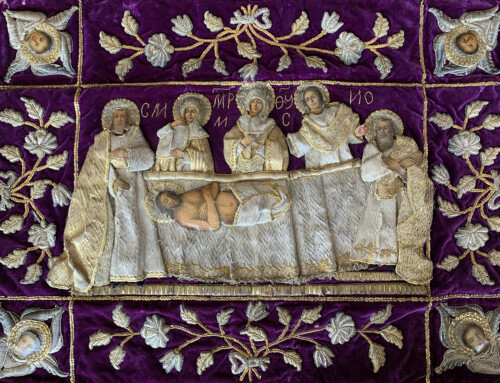On Saturday, December 17, 2016, Sr. Elizaveta, OSBM from the Sisters of St. Basil in Ukraine visited Saint Josaphat Ukrainian Catholic Cathedral and spoke about the blessed Martyrs of the 20th century of Ukraine.
On June 27, 2001, Pope John Paul II beatified twenty-eight Ukrainian martyrs: bishops, priests, nuns, and one layman who suffered and died for Christ and His Vicar under the communist scourge.
List of martyrs:
- Sister Josaphata Hordashevska: She was born in Lviv in 1869. In 1892, she founded what would be the largest female religious community in the Ukrainian Catholic Church, the Sisters Servants of Mary Immaculate. An example of holiness and charity in performing her labors among the poor, she died of bone cancer in 1919.
- Priest and Martyr, Nicholas Konrad: Born in 1876, he studied for the priesthood in Rome. He was ordained in 1899. He was very active with the Catholic students whom he taught in Lviv, forming an association with them, called Renewal, to enhance their spiritual lives. Returning from a sick call, he was accosted by thugs from the KGB and beaten to death on June 26, 1941.
- Martyr Volodymyr, Cantor: He was martyred together with Father Konrad.
- Priest and Martyr, Andrew Ishchak: Born in Lviv region. After earning his doctorate in theology in 1914, he was ordained a priest. He taught at the Lviv Theological Academy. While doing pastoral work, he was killed for the Faith by soldiers of the retreating Red Army on June 26, 1941. Notice that the first three of the martyrs listed were slain on the same day, June 26, 1941.
- Priest and Martyr, Severian Baranyk: Born in 1889, he joined the Basilian Fathers in 1904. He became prior of a Basilian monastery, where he was known for his habitual joy and his work with the youth and orphans. He was arrested by the KGB and sent to prison and died there of multiple fractures in June, 1941.
- Priest and Martyr, Joachim Senkivskyi: Born in 1896, he was ordained a priest in 1921. He earned a doctorate in theology at the University of Innsbruck, afterwards he joined the Basilians. Father Joachim was extremely active doing pastoral work in several villages and, later, he was made abbot of a Basilian monastery. He was arrested during the blitzkrieg KGB sweep of June 26, 1941 and sent to the local prison. Three days later, according to the testimony of other prisoners, he was boiled to death.
- Priest and Martyr, Zynovil Kovalyk: Born in 1903, he entered the Redemptorists in 1926. After studying in Belgium, he returned to Ukraine and was ordained in 1937. In 1940, while preaching a homily he was seized by the Reds and thrown into prison. He was tortured horribly during his incarceration and finally crucified in mockery of His Savior at the end of June, 1941.
- Priest and Martyr, Emilian Kowcz: Born in 1884, he went to Rome to study for the priesthood. There, he was ordained in 1911. Father Emilian was a married man prior to ordination. He served as chaplain for a while and worked among the poor and the soldiers during WWII. Arrested by the Gestapo, he died praying for and giving consolation to fellow prisoners in a concentration camp in 1942.
- Nun and Martyr, Sister Tarsykiia Matskiv: She made her religious profession in 1940 with the Sisters Servants of Mary Immaculate, founded by Blessed Sister Josaphata. Even before the Reds over ran Lviv she had made a private vow with her confessor to sacrifice her life for the conversion of Russia and the good of the Church. On July 17, 1944, Soviet soldiers surrounded her convent. Sister heard a knock at the door and opened it, thinking it was a priest whose arrival the sisters were awaiting. A shot rang out and Sister Tarsykiia fell dead. Her sacrificial intention was accepted unto martyrdom.
- Priest and Martyr, Vitalis Bairak: Born in 1907, he entered the Basilian Order in 1924. In 1941 he was appointed superior of the Drohobych monastery to take the place of recently martyred Father Joachim. He was arrested by the KGB in 1945 and sent to the same local prison where Father Joachim was boiled to death. In this horror house he was savagely beaten and, just prior to Easter, 1946, he died of his wounds.
- Priest and Martyr, Roman Lysko: Born in 1914 in the Lviv region. Married, he attended the Lviv Theological Academy. He was ordained a priest by Metropolitan Sheptytsky. Refusing to sign a statement of conversion to the Orthodox Church, he was arrested in 1949 and imprisoned in Lviv and allowed no visitors. The date of his death is unknown. Reports had it that he was sealed up alive in a wall, a martyr for the Faith and Church unity.
- Bishop and Martyr, Gregory Khomyshyn: Born in 1867, he attended the Lviv seminary in his youth. Ordained in 1893, he continued studies in Vienna, where he earned a doctorate. Metropolitan Sheptytsky appointed him rector of the Lviv seminary and consecrated him a bishop in 1904. He was arrested by the KGB for the first time in 1939 and again in 1945. He died of ill health that same year while in prison.
- Bishop and Martyr, Theodore Romzha: Born in 1911, he went to Rome to study for the priesthood at the Gregorian University. After ordination he returned to Ukraine where he was assigned pastoral work in remote villages. He also taught philosophy in the seminary. In 1944 he was consecrated bishop, and in his post as shepherd he refused every attempt by the communists to get him to join the Orthodox Church. In October, 1947, communist soldiers rammed a military vehicle into his carriage in an attempt to kill him and his companions. Seeing that he survived, they beat him and the others into unconsciousness. While recovering in a hospital he was poisoned to death.
- Bishop and Martyr, Josaphat Kotsylovskyi: Born in 1876, he studied for the priesthood in Rome. After ordination, he taught theology at the Stanislaviv Seminary in Ukraine. He entered the Basilian Order during this time. In 1917, when Metropolitan Sheptytsky returned from prison in Russia, he consecrated Father Josaphat a bishop in Poland. The bishop was arrested in Poland by the communists who took him to Russia and then to a prison in Kiev. He died a martyr in a concentration camp in Kiev in 1947.
- Bishop and Martyr, Nykyta Budka: Born in 1877, he was ordained to the priesthood in 1905 by Metropolitan Sheptytsky. Assigned to minister to Ukrainian emigrants, he was consecrated bishop in 1912 and appointed the first bishop for Ukrainian Catholics in Canada. In 1928, he returned to Lviv, where he served as Vicar General for the Metropolitan’s curia. Arrested with other bishops in 1945, he was sent to the gulag. He died in a labor camp in Kazakhstan in 1949.
- Bishop and Martyr, Gregory Lakota: Born in 1883 in the Lviv region, he studied theology at the Lviv Academy. He was ordained to the priesthood in Poland in 1908. He served for eighteen years as professor and rector in the seminary at Przemysl before being consecrated that city’s bishop in 1926. Arrested in 1946, he was sentenced to ten years imprisonment. He was then exiled to a labor camp in Vorkuta, Russia. Bishop Gregory was beloved by his fellow prisoners, often taking on the labors of others in order to ease their suffering. He died near Vorkuta in 1950.
- Priest and Martyr, Archimandrite Clement Sheptytsky: Younger brother of Metropolitan Sheptytsky, Abbot Clement was born in 1869. He studied law and received a doctorate from the University of Krakow. After serving various governmental positions in Austria, he entered the Studite monastery in 1912. He was ordained a priest in 1915. He was elected prior and later abbot of the Studite monastery at Univ, Ukraine. In 1947, the abbot was arrested by the KGB in Kiev. He died in prison in 1951 in Vladmir, Russia.
- Priest and Martyr, Nicholas Tsehelskyi: Born in 1896, he graduated from the Theology Academy at Lviv University in 1923. He was ordained a priest in 1925 by Metropolitan Sheptytsky. He suffered much as a priest, both from threats and beatings, because he refused to become an Orthodox. He was arrested by the Reds in 1946 and sentenced to ten years imprisonment. Father Nicholas had a wife and three children who were taken into custody and sent to Russia’s Chita region. Father Nicholas was deported to a notoriously severe labor camp in Russia’s Mordovia. Here he died, in 1951, while enduring with great patience a painful illness that resulted from his cruel treatment.
- Priest and Martyr, Ivan Ziatyk: Born in 1899, he was ordained in 1923. Twelve years later, he joined the Redemptorists. He was appointed superior of the congregation in Ternopil, and served in this capacity during the Nazi occupation. He was arrested by the communists in 1950 for the crime of “preaching the ideas of the Pope of Rome regarding the spread of the Catholic Faith among the nations of the whole world.” He was sent to prison in Russia where he endured the torture of seventy-five interrogation sessions. He gave his life for Christ in 1952 after being savagely beaten and thrown out in the cold drenched with water. He died later in the prison infirmary.
- Nun and Martyr, Sister Olympia Bida: Born in 1903 in the Lviv region of Ukraine, she entered as a young woman the congregation of the Sisters of Saint Joseph. She later became the superior of one of their convents. When the Soviets took over Ukraine after WWII, the convent suffered a number of attacks. In 1950, she was arrested by soldiers of the KGB and taken to a harsh labor camp in Siberia. She was sentenced for her “anti-Soviet activities.” This is where she died, in 1952, after enduring intense suffering.
- Nun and Martyr, Sister Lavrentia Herasymiv: Born in the Lviv region in 1911, she entered the convent of the Sisters of Saint Joseph in Tsebliv at the age of twenty. After taking first vows she joined Sister Olympia at the convent in Khyriv. She was arrested with Sister Olympia in 1950 and, already sick with tuberculosis, sent to the same labor camp. She died the same year as her devoted companion from the inhuman conditions in which she was forced to live.
- Priest and Martyr, Peter Verhun: Born in the Lviv region in 1890, he studied philosophy and earned a Ph.D. He was ordained a priest by Metropolitan Sheptytsky in 1927 and later sent to Germany as Apostolic Visitator for the Ukrainian Catholics who lived there. Beloved by his flock, he was hated by the Soviet communists in Berlin. They arrested him and sent him to do eight years of hard labor in Siberia. He continued his priestly work among the prisoners amid the harshest of conditions. He died in exile in 1957.
- Priest and Martyr, Oleksii Zarytskyi: Born in the Lviv region in 1912, he pursued his studies as a young man at the Theological Academy in Lviv. Metropolitan Sheptytsky ordained him a priest in 1936 and assigned him to serve as pastor in the village of Strutyn. The KGB arrested him in 1948 and sentenced him to a labor camp in Siberia for the crime of refusing to renounce his Catholic Faith and join the Orthodox Church. After his release he returned to western Ukraine and worked tirelessly, not only among his own people, but among Poles, Germans, and even Russians. Despite the danger, he visited Metropolitan Josef Slipyi when he was in exile. Arrested a second time, he was sent to a labor camp in Karaganda where he died two years later in 1963.
- Bishop and Martyr Nicholas Charnetskyi: Born in 1884, in the Stanislaviv region of Ukraine, he studied for the priesthood first in Ukraine, then in Rome. He was ordained in Rome in 1909 after earning a doctorate in dogmatic theology. Returning to Ukraine, he taught in the seminary at Stanislaviv and, ten years later, joined the Redemptorists in Lviv. In 1926, he was appointed Apostolic Visitator for the eastern rite Catholics living in Poland. His main work was trying to ignite a desire among the Orthodox to return to unity under the pope. In 1931, Father Nicholas was consecrated a bishop. Fourteen years later his Calvary began in earnest. Arrested by the KGB in 1945, he was sent to a notoriously hard labor camp in Siberia. For the next eleven years he was interrogated for a total of six hundred hours, tortured, and shuffled around thirty different camps. Terminally ill, he was allowed to return to Ukraine in 1956 where he continued to perform his episcopal duties. Known for his outstanding patience and goodness, he was, in his own lifetime, considered a saint. He died as a result of his maltreatment in 1959.
- Bishop and Martyr, Simeon Lukach: Born in 1893, he entered the seminary of Stanislaviv near his home village. Ordained in 1919, he taught moral theology at the same seminary. Secretly, in 1945, he was consecrated a bishop by Blessed Bishop Gregory Chomyshyn, who was expecting his own imminent arrest. Bishop Gregory’s account was given earlier in this tribute. A year later, the Bishop was arrested by the Soviet KGB and sentenced to hard labor at a lumber camp in Krasnoyarsk. He was freed in 1955 and returned to Ukraine. In 1962, he was arrested again and sent to a worse camp. After two years, dying from tuberculosis, the Bishop was allowed to return to his home village. He died a martyr shortly thereafter, in 1964, as a result of his maltreatment.
- Bishop and Martyr, Ivan Sleziuk: Born in 1896 in the same region as the two previously-mentioned martyrs, he entered the eparchial seminary, graduating in 1923, and ordained the same year. He, too, was secretly ordained by Bishop Gregory Chomyshyn just prior to the latter’s arrest in 1945. Two months after his consecration, he was arrested and sent to a labor camp in Moldovia, Russia. When he was released he returned to his post and served as eparchical administrator. But, in 1962, he was arrested again, together with Bishop Simeon Lukach. Six more years were spent in hard labor. Even after his release in 1968, he was continually harassed by the KGB. After one of their sadistic summons for a “conversation,” he fell so ill that he never recovered. He died a martyr in 1973.
- Bishop and Martyr, Basil Velychkovskyi: Born in 1903, also in the Stanislaviv region, he entered the seminary in Lviv. In 1925, he was ordained and took vows as a Redemptorist. After years of missionary work in Volyn, he was elected prior for the house in Ternopil. He was arrested in 1945 and sentenced to hard labor at a Siberian camp above the Arctic Circle. Released in 1955, he returned to Lviv where he continued with his pastoral work. In 1963, in a Moscow hotel, he was secretly consecrated an archbishop by Metropolitan Slipyi, who was on his way to exile in Rome. His assignment was to head the underground Ukrainian Catholic Church and to secure the apostolic succession for the catacombed UGCC. In 1969, Archbishop Basil was arrested again and sent to prison where he was subjected to physical, chemical, and psychological torture. Three years later, he was released but sent outside the USSR and Ukraine into exile. With a failing heart, caused by the treatment he received in prison, he went to Canada to lead the Ukrainian Catholic diaspora which had immigrated to that country. Archbishop Basil died a martyr, in Winnipeg, in June of 1973. There is a martyrs shrine, dedicated to him and other Redemptorist martyrs, at Saint Joseph’s Ukrainian Catholic Church in Winnipeg. Pilgrims have flocked to his tomb seeking healings ever since his mortal remains, fully intact, were transferred to the shrine in 2002.
- Martyr and Exarch, Leonid Feodorov. The brief sketch of his life was given earlier.
